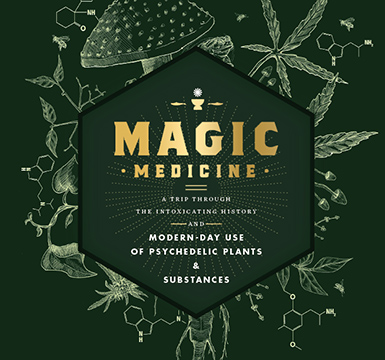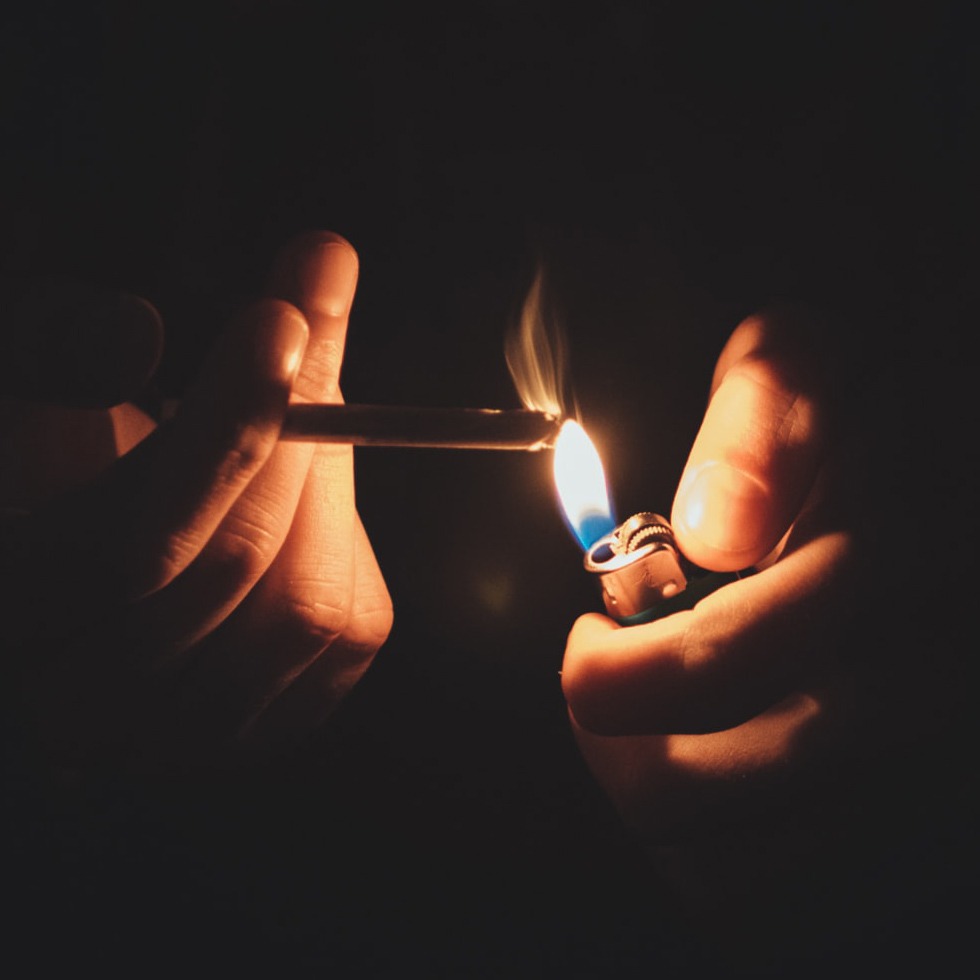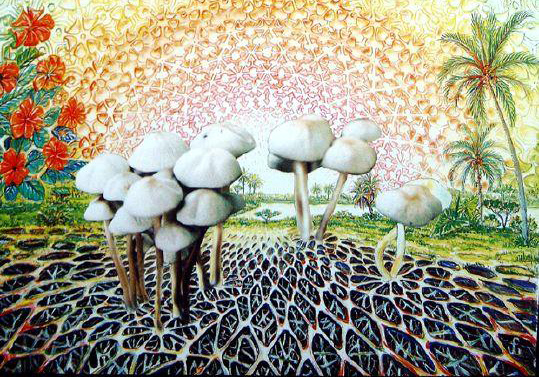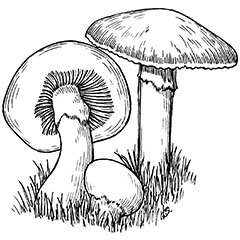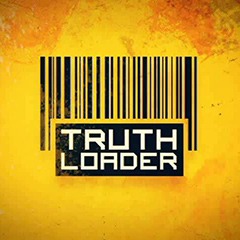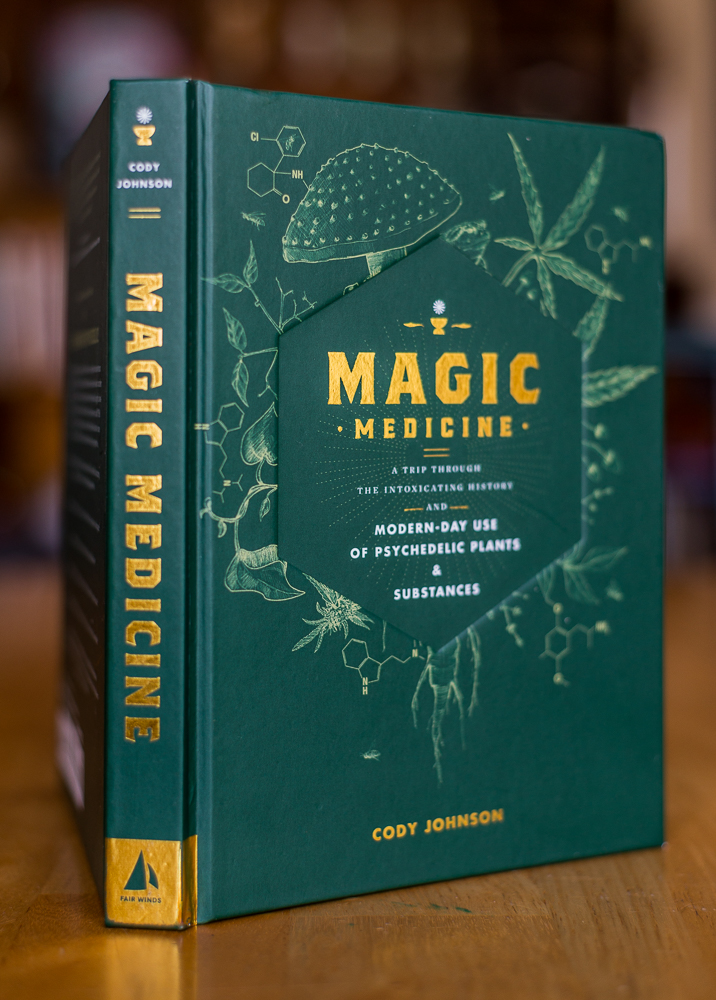How a Banker Introduced ‘Magic Mushrooms’ to the West
by Psychedelic Frontier on Jul 15, 2014 4 CommentsIn 1955, banker and amateur mycologist R. Gordon Wasson traveled to Mexico with a friend, where they became “the first white men in recorded history to eat the divine mushrooms.” Seeking the Magic Mushroom, published two years later in Life magazine, introduced psilocybin mushrooms to the West. Wasson wrote about his personal experience eating the mushrooms, and their ceremonial use by the Mazatec people as a healing agent.
The essay came at a perfect time, exposing a whole generation of young people to a natural, non-toxic, and easily grown psychedelic agent that had long been overlooked in the West. Wasson’s testimony also showed that such compounds had a long history of spiritual and therapeutic use, and were not just for reckless hedonists. Since the starry-eyed hippies of the 60s had no other guidance for taking mushrooms, this ceremonial context set a valuable precedent (although, then as now, not everyone was interested in taking the experience seriously).
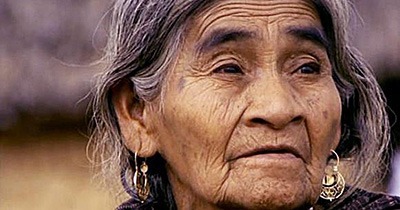
Maria Sabina, the curandera who served mushrooms to Gordon Wasson
Wasson’s story profoundly influenced the psychedelic movement of the 1960s, and led many people to visit curandera Maria Sabina (whom Wasson unsuccessfully attempted to protect by using the pseudonym Eva Mendez). After reading the article, Timothy Leary traveled to Mexico and had his own mushroom experience, which ignited his journey as psychedelic guru. As soon as he returned from Mexico in 1960, he started the Harvard Psychedelic Project with Richard Alpert (Ram Dass). If it weren’t for Wasson’s expedition, ‘shrooms’ may have remained an obscure mystery, and Timothy Leary may never have become a household name.
In the next decade, thousands of other spiritual tourists, including Bob Dylan, John Lennon, Mick Jagger, and Keith Richards, all descended upon Sabina’s little village in the hopes of tasting the divine mushroom. As you can imagine, this wasn’t all good news for the traditional Mazatec community, and Maria Sabina eventually came to regret serving the mushrooms to foreigners.
Today everyone knows about “magic mushrooms,” and you can order grow kits to your door in a matter of minutes. But I invite you to step back to 1957, a time when most of the world knew nothing about these mysterious fungi and their ceremonial use by the Mazatec people. Imagine yourself in Wasson’s shoes, on the frontiers of a state of consciousness never before explored by Westerners. Prepare to be amazed.
![]()
Seeking the Magic Mushroom
by R. Gordon Wasson
A New York banker goes to Mexico’s mountains to participate in the age-old rituals of Indians who chew strange growths that produce visions
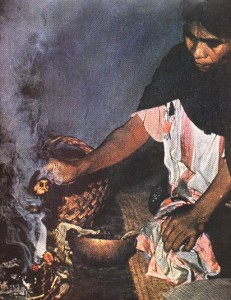
Preparing for ceremony at which author chewed hallucinogenic mushrooms and had visions, Curandera Eva Mendez ceremonially turns fungus in the smoke of burning aromatic leaves.
The author of this article, a vice president of J.P. Morgan & Co. Incorporated, together with his wife, Valentina P. Wasson, M.D., a New York pediatrician, has spent the last four summers in remote mountains of Mexico. The Wassons have been on the trail of strange and hitherto unstudied mushrooms with vision-giving powers.
They have been pursuing the cultural role of wild mushrooms for 30 years. Their travels and inquiries throughout the world have led them to some surprising discoveries in this field in which they are pioneers. They are now publishing their findings in Mushrooms Russia and History, a large, richly illustrated two-volume book, which is limited to 500 copies and is now on sale at $125 (Pantheon Books, New York).
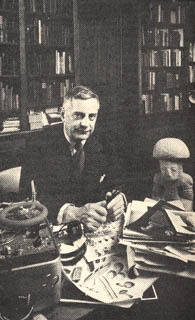
Author Wasson sits in New York home with recorder, mushroom pictures and “mushroom stone.” A onetime newspaperman, he took up banking in 1928.
On the night of June 29-30,1955, in a Mexican Indian village so remote from the world that most of the people still speak no Spanish, my friend Allan Richardson and I shared with a family of Indian friends a celebration of “holy communion” where “divine” mushrooms were first adored and then consumed. The Indians mingled Christian and pre-Christian elements in their religious practices in a way disconcerting for Christians but natural for them. The rite was led by two women, mother and daughter, both of them curanderas, or shamans. The proceedings went on in the Mixeteco language. The mushrooms were of a species with hallucinogenic powers; that is, they cause the eater to see visions. We chewed and swallowed these acrid mushrooms, saw visions, and emerged from the experience awestruck. We had come from afar to attend a mushroom rite but had expected nothing so staggering as the virtuosity of the performing curanderas and the astonishing effects of the mushrooms. Richardson and I were the first white men in recorded history to eat the divine mushrooms, which for centuries have been a secret of certain Indian peoples living far from the great world in southern Mexico. No anthropologists had ever described the scene that we witnessed.
I am a banker by occupation and Richardson is a New York society photographer and is in charge of visual education at The Brearley School.
It was, however, no accident that we found ourselves in the lower chamber of that thatch-roofed, adobe-walled Indian home. For both of us this was simply the latest trip to Mexico in quest of the mushroom rite. For me and my wife, who was to join us with our daughter a day later, it was a climax to nearly 30 years of inquiries and research into the strange role of toadstools in the early cultural history of Europe and Asia.
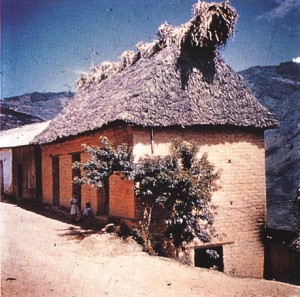
House where mushroom sessions took place is built of adobe, has thatch “dog-ears” over gable ends. Door, lower right, leads into ceremonial room.
Thus that June evening found us, Allan Richardson and me, deep in the south of Mexico, bedded down with an Indian family in the heart of the Mixeteco mountains at an altitude of 5,500 feet. We could stay only a week or so: we had no time to lose. I went to the municipio or town hall, and there I found the official in charge, the sindico, seated alone at his great table in an upper room. He was a young Indian, about 35 years old, and he spoke Spanish well. His name was Filemon. He had a friendly manner and I took a chance. Leaning over his table, I asked him earnestly and in a low voice if I could speak to him in confidence. Instantly curious, he encouraged me. “Will you,” I went on, “help me learn the secrets of the divine mushroom?” and I used the Mixeteco name, ‘nti sheeto, correctly pronouncing it with glottal stop and tonal differentiation of the syllables. When Filemon recovered from his surprise he said warmly that nothing could be easier. He asked me to pass by his house, on the outskirts of town, at siesta time.
Allan and I arrived there at about 3 o’clock. Filemon’s home is built on a mountainside, with a trail on one side at the level of the upper story and a deep ravine on the other. Filemon at once led us down the ravine to a spot where the divine mushrooms were growing in abundance. After photographing them we gathered them in a cardboard box and then labored back up the ravine in the heavy moist heat of that torrid afternoon. Not letting us rest Filemon sent us high up above his house to meet the curandera, the woman who would officiate at the mushroom rite. A connection of his, Eva Mendez by name, she was a curandera de primera categoria, of the highest quality, una Senora sin mancha, a woman without stain. We found her in the house of her daughter, who pursues the same vocation. Eva was resting on a mat on the floor from her previous night’s performance. She was middle-aged, and short like all Mixetecos, with a spirituality in her expression that struck us at once. She had presence. We showed our mushrooms to the woman and her daughter. They cried out in rapture over the firmness, the fresh beauty and abundance of our young specimens. Through an interpreter we asked if they would serve us that night. They said yes.
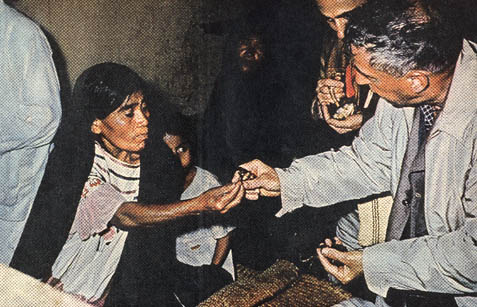
Receiving his mushrooms, Wasson takes his night’s ration from the hand of Curandera Eva Mendez. In right background GUY Stresser-Pean, French anthropologist who accompanied Wasson, has begun to chew his own supply.
About 20 of us gathered in the lower chamber of Filemon’s house after 8 o’clock that evening. Allan and I were the only strangers, the only ones who spoke no Mixeteco. Only our hosts, Filemon and his wife, could talk to us in Spanish. The welcome accorded to us was of a kind that ,we had never experienced before in the Indian country. Everyone observed a friendly decorum. They did not treat us stiffly, as strange white men; we were of their number. The Indians were wearing their best clothes, the women dressed in their huipiles or native costumes, the men in clean white trousers tied around the waist with strings and their best serapes over their clean shirts. They gave us chocolate to drink, somewhat ceremonially, and suddenly I recalled the words of the early Spanish writer who had said that before the mushrooms were served, chocolate was drunk. I sensed what we were in for: at long last we were discovering that the ancient communion rite still survived and we were going to witness it. The mushrooms lay there in their box, regarded by everyone respectfully but without solemnity. The mushrooms are sacred and never the butt of the vulgar jocularity that is often the way of white men with alcohol.
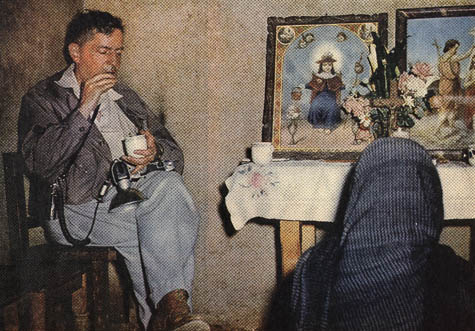
Eating his mushrooms, Wasson takes them from cup holding his night’s quota as the curandera prays at the household altar. He chewed them slowly, as is the custom, and his six pair took about a half hour to eat.
Before midnight the Senora (as Eva Mendez is usually called) broke a flower from the bouquet on the altar and used it to snuff out the flame of the only candle that was still burning. We were left in darkness and in darkness we remained until dawn. For a half hour we waited in silence. Allan felt cold and wrapped himself in a blanket. A few minutes later he leaned over and whispered, “Gordon, I am seeing things!” I told him not to worry, I was too. The visions had started. They reached a plateau of intensity deep in the night, and they continued at that level until about 4 o’clock. We felt slightly unsteady on our feet and in the beginning were nauseated. We lay down on the mat that had been spread for us, but no one had any wish to sleep except the children, to whom mushrooms are not served. We were never more wide awake, and the visions came whether our eyes were opened or closed. They emerged from the center of the field of vision, opening up as they came, now rushing, now slowly, at the pace that our will chose. They were in vivid color, always harmonious. They began with art motifs, angular such as might decorate carpets or textiles or wallpaper or the drawing board of an architect. Then they evolved into palaces with courts, arcades, gardens—resplendent palaces all laid over with semiprecious stones. Then I saw a mythological beast drawing a regal chariot. Later it was as though the walls of our house had dissolved, and my spirit had flown forth, and I was suspended in mid-air viewing landscapes of mountains, with camel caravans advancing slowly across the slopes, the mountains rising tier above tier to the very heavens. Three days later, when I repeated the same experience in the same room with the same curanderas, instead of mountains I saw river estuaries, pellucid water flowing through an endless expanse of reeds down to a measureless sea, all by the pastel light of a horizontal sun. This time a human figure appeared, a woman in primitive costume, standing and staring across the water, enigmatic, beautiful, like a sculpture except that she breathed and was wearing woven colored garments. It seemed as though I was viewing a world of which I was not a part and with which I could not hope to establish contact. There I was, poised in space, a disembodied eye, invisible, incorporeal, seeing but not seen.
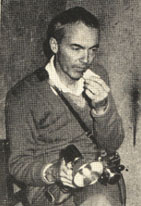
Allan Richardson eats a mushroom in spite of his pledge to his wife.
The visions were not blurred or uncertain. They were sharply focused, the lines and colors being so sharp that they seemed more real to me than anything I had ever seen with my own eyes. I felt that I was now seeing plain, whereas ordinary vision gives us an imperfect view; I was seeing the archetypes, the Platonic ideas, that underlie the imperfect images of everyday life. The thought crossed my mind: could the divine mushrooms be the secret that lay behind the ancient Mysteries? Could the miraculous mobility that I was now enjoying be the explanation for the flying witches that played so important a part in the folklore and fairy tales of northern Europe? These reflections passed through my mind at the very time that I was seeing the visions, for the effect of the mushrooms is to bring about a fission of the spirit, a split in the person, a kind of schizophrenia, with the rational side continuing to reason and to observe the sensations that the other side is enjoying. The mind is attached as by an elastic cord to the vagrant senses.
Meanwhile the Senora and her daughter were not idle. When our visions were still in the initial phases, we heard the Senora waving her arms rhythmically. She began a low, disconnected humming. Soon the phrases became articulate syllables, each disconnected syllable cutting the darkness sharply. Then by stages the Senora came forth with a full-bodied canticle, sung like very ancient music. It seemed to me at the time like an introit to the Ancient of Days. As the night progressed her daughter spelled her at singing. They sang well, never loud, with authority. What they sang was indescribably tender and moving, fresh, vibrant, rich. I had never realized how sensitive and poetic an instrument the Mixeteco language could be. Perhaps the beauty of the Senora’s performance was partly an illusion induced by the mushrooms; if so, the hallucinations are aural as well as visual. Not being musicologists, we know not whether the chants were wholly European or partly indigenous in origin. From time to time the singing would rise to a climax and then suddenly stop, and then the Senora would fling forth spoken words, violent, hot, crisp words that cut the darkness like a knife. This was the mushroom speaking through her, God’s words, as the Indians believe, answering the problems that had been posed by the participants. This was the Oracle. At intervals, perhaps every half hour, there was a brief intermission, when the Senora would relax and some would light cigarets.
At one point, while the daughter sang, the Senora stood up in the darkness where there was an open space in our room and began a rhythmic dance with clapping or slapping. We do not know exactly how she accomplished her effect. The claps or slaps were always resonant and true. So far as we know, she used no device, only her hands against each other or possibly against different parts of her body. The claps and slaps had pitch, the rhythm at times was complex, and the speed and volume varied subtly. We think the Senora faced successively the four points of the compass, rotating clockwise, but are not sure. One thing is certain: this mysterious percussive utterance was ventriloquistic, each slap coming from an unpredictable direction and distance, now close to our ears, now distant, above, below, here and yonder, like Hamlet’s ghost hic et ubique. We were amazed and spellbound, Allan and I.
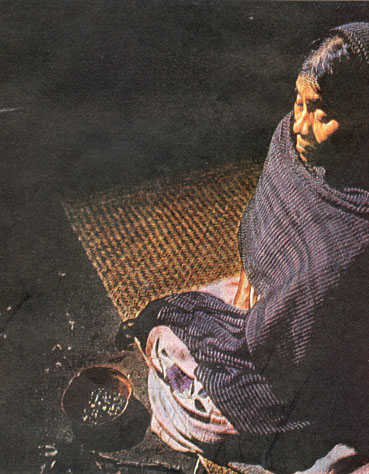
Meditating silently, Eva Mendez sits before her mushroom bowl. Though she ate twice as many mushrooms as the rest, she stayed calm and dignified, often lyrical in her exhortations, sometimes impatient when spirits did not come.
There we lay on our mat, scribbling notes in the dark and exchanging whispered comments, our bodies inert and heavy as lead, while our senses were floating free in space, feeling the breezes of the outdoors, surveying vast landscapes or exploring the recesses of gardens of ineffable beauty. And all the while we were listening to the daughter’s chanting and to the unearthly claps and whacks, delicately controlled, of the invisible creatures darting around us.
The Indians who had taken the mushrooms were playing a part in the vocal activity. In the moments of tension they would utter exclamations of wonder and adoration, not loud, responsive to the singers and harmonizing with them, spontaneously yet with art.
On that initial occasion we all fell asleep around 4 o’clock in the morning. Allan and I awoke at 6, rested and heads clear, but deeply shaken by the experience we had gone through. Our friendly hosts served us coffee and bread. We then took our leave and walked back to the Indian house where we were staying, a mile or so away.
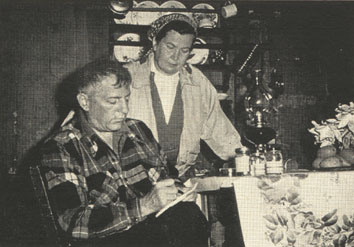
On morning after eating mushrooms, Wasson and his wife review his notes, taken in the dark. Jars contain mushrooms later sent to Heim.
![]()
From the many mushroom celebrations that I have now witnessed, nine in all, it is clear to me that at least in the Mixeteco country the congregation is indispensable to the rite. Since the congregation, in order to participate, must be brought up in the tradition, any white persons should be greatly outnumbered by the Indians. But this does not mean that the mushrooms lose their potency if not eaten communally. My wife and our daughter Masha, 18, joined us a day after the ceremony that I have described, and on July 5, in their sleeping bags, they ate the mushrooms while alone with us. They experienced the visions too. They saw the same brilliant colors; my wife saw a ball in the Palace of Versailles with figures in period costumes dancing to a Mozart minuet. Again, on Aug. 12, 1955, six weeks after I had gathered the mushrooms in Mexico, I ate them in a dried state in my bedroom in New York, and found that if anything they had gained in their hallucinogenic potency.
![]()
It was a walk in the woods, many years ago, that launched my wife and me on our quest of the mysterious mushroom. We were married in London in 1926, she being Russian, born and brought up in Moscow. She had lately qualified as a physician at the University of London. I am from Great Falls, Mont. of Anglo-Saxon origins. In the late summer of 1927, recently married, we spent our holiday in the Catskills. In the afternoon of the first day we went strolling along a lovely mountain path, through woods crisscrossed by the slanting rays of a descending sun. We were young, carefree and in love. Suddenly my bride abandoned my side. She had spied wild mushrooms in the forest, and racing over the carpet of dried leaves in the woods, she knelt in poses of adoration before first one cluster and then another of these growths. In ecstasy she called each kind by an endearing Russian name. She caressed the toadstools, savored their earthy perfume. Like all good Anglo-Saxons, I knew nothing about the fungal world and felt that the less I knew about those putrid, treacherous exorescences the better. For her they were things of grace, infinitely inviting to the perceptive mind. She insisted on gathering them, laughing at my protests, mocking my horror. She brought a skirtful back to the lodge. She cleaned and cooked them. That evening she ate them, alone. Not long married, I thought to wake up the next morning a widower.
These dramatic circumstances, puzzling and painful for me, made a lasting impression on us both. From that day on we sought an explanation for this strange cultural cleavage separating us in a minor area of our lives. Our method was to gather all the information we could on the attitude toward wild mushrooms of the Indo-European and adjacent peoples. We tried to determine the kinds of mushrooms that each people knows, the uses to which these kinds are put, the vernacular names for them. We dug into the etymology of those names, to arrive at the metaphors hidden in their roots. We looked for mushrooms in myths, legends, ballads, proverbs, in the writers who drew their inspiration from folklore, in the clichés of daily conversation, in slang and the telltale recesses of obscene vocabularies. We sought them in the pages of history, in art, in Holy Writ. We were not interested in what people learn about mushrooms from books, but what untutored country folk know from childhood, the folk legacy of the family circle. It turned out that we had happened on a novel field of inquiry.
![]()
As the years went on and our knowledge grew, we discovered a surprising pattern in our data: each Indo-European people is by cultural inheritance either “mycophobe” or “mycophile,” that is, each people either rejects and is ignorant of the fungal world or knows it astonishingly well and loves it. Our voluminous and often amusing evidence in support of this thesis fills many sections of our new book, and it is there that we submit our case to the scholarly world. The great Russians, we find, are mighty mycophiles, as are also the Catalans, who possess a mushroomic vocabulary of more than 200 names. The ancient Greeks, Celts, and Scandinavians were mycophobes, as are the Anglo-Saxons. There was another phenomenon that arrested our attention: wild mushrooms from earliest times were steeped in what the anthropologists call mana, a supernatural aura. The very word “toadstool” may have meant originally the “demonic stool” and been the specific name of a European mushroom that causes hallucinations. In ancient Greece and Rome there was a belief that certain kinds of mushrooms were procreated by the lightning bolt. We made the further discovery that this particular myth, for which no support exists in natural science, is still believed among many widely scattered peoples: the Arabs of the desert, the peoples of India, Persia and the Pamirs, the Tibetans and Chinese, the Filipinos and the Maoris of New Zealand, and even among the Zapotecs of Mexico…. All of our evidence taken together led us many years ago to hazard a bold surmise: was it not probable that, long ago, long before the beginnings of written history, our ancestors had worshiped a divine mushroom? This would explain the aura of the supernatural in which all fungi seem to be bathed. We were the first to offer the conjecture of a divine mushroom in the remote cultural background of the European peoples, and the conjecture at once posed a further problem: what kind of mushroom was once worshiped and why?
Our surmise turned out not to be farfetched. We learned that in Siberia there are six primitive peoples—so primitive that anthropologists regard them as precious museum pieces for cultural study—who use an hallucinogenic mushroom in their shamanistic rites. We found that the Dyaks of Borneo and the Mount Hagen natives of New Guinea also have recourse to similar mushrooms. In China and Japan we came upon an ancient tradition of a divine mushroom of immortality, and in India, according to one school, the Buddha at his last supper ate a dish of mushrooms and was forthwith translated to nirvana.
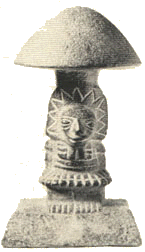
“Mushroom stone” from the highlands of Guatemala dates back to 300 – 600 AD
When Cortez conquered Mexico, his followers reported that the Aztecs were using certain mushrooms in their religious celebrations, serving them, as the early Spanish friars put it, in a demonic holy communion and calling them teonanacatl, “God’s flesh.” But no one at that time made a point of studying this practice in detail, and until now anthropologists have paid little attention to it. We with our interest in mushrooms seized on the Mexican opportunity, and for years have devoted the few leisure hours of our busy lives to the quest of the divine mushroom in Middle America. We think we have discovered it in certain frescoes in the Valley of Mexico that date back to about 400 A.D., and also in the “mushroom stones” carved by the highland Maya of Guatemala that go back in one or two instances to the earliest era of stone carvings, perhaps 1000 B.C.
For a day following our mushroom adventure Allan and I did little but discuss our experience. We had attended a shamanistic rite with singing and dancing among our Mixeteco friends which no anthropologist has ever before described in the New World, a performance with striking parallels in the shamanistic practices of some of the archaic Palaeo-Siberian peoples. But may not the meaning of what we had witnessed go beyond this’? The hallucinogenic mushrooms are a natural product presumably accessible to men in many parts of the world, including Europe and Asia. In man’s evolutionary past, as he groped his way out from his lowly past, there must have come a moment in time when he discovered the secret of the hallucinatory mushrooms. Their effect on him, as I see it, could only have been profound, a detonator to new ideas. For the mushrooms revealed to him worlds beyond the horizons known to him, in space and time, even worlds on a different plane of being, a heaven and perhaps a hell. For the credulous primitive mind, the mushrooms must have reinforced mightily the idea of the miraculous. Many emotions are shared by men with ,the animal kingdom, but awe and reverence and the fear of God are peculiar to men. When we bear in mind the beatific sense of awe and ecstasy and caritas engendered by the divine mushrooms, one is emboldened to the point of asking whether they may not have planted in primitive man the very idea of a god.
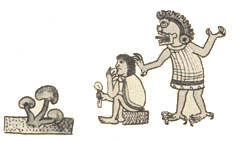
Mexican drawing of 16th Century shows three mushrooms, a man eating them and a god behind him, who is speaking through the mushroom.
It is no accident, perhaps, that the first answer of the Spanish-speaking Indian, when I asked about the effect of the mushrooms, was often this: Le llevan ahí donde Dios está, “They carry you there where God is,” an answer that we have received on several occasions, from Indians in different cultural areas, almost as though it were in a sort of catechism. At all times there have been rare souls—the mystics and certain poets—who have had access without the aid of drugs to the visionary world for which the mushrooms hold the key. William Blake possessed the secret: ”He who does not imagine in . . . stronger and better light than his perishing mortal eye can see, does not imagine at all.” But I can testify that the mushrooms make those visions accessible to a much larger number. The visions that we saw must have come from within us, obviously. But they did not recall anything that we had seen with our own eyes. Somewhere within us there must lie a repository where these visions sleep until they are called forth. Are the visions a subconscious transmutation of things read and seen and imagined, so transmuted that when they are conjured forth from the depths we no longer recognize them? Or do the mushrooms stir greater depths still, depths that are truly the Unknown?
![]()
In each of our successive trips to the Indian peoples of southern Mexico, we have enlarged our knowledge of the use of the divine mushrooms, and as our knowledge has increased, new and exciting questions keep arising. We have found five distinct cultural areas where the Indians invoke the mushrooms, but the usage varies widely in every area. What is needed is a perceptive approach by trained anthropologists in every area, cooperating with mushroom specialists. Of these latter there are in the whole world relatively few: mushrooms are a neglected field in the natural sciences. In this field Professor Roger Heim is known the world over. He is not only a man with vast experience in the field of mushrooms: he is an outstanding scientist in other fields, a man steeped in the humanities, the head of the Museum National d’Histoire Naturelle in Paris. At an early stage of our inquiries he had lent us his counsel, and in 1956 our progress had been such as to justify him in accompanying us on another field trip. There came with us also a chemist, Professor James A. Moore of the University of Delaware; an anthropologist, Guy Stresser-Pean of the Sorbonne; and once again our loyal friend Allan Richardson as photographer.
This time the immediate problem was to identify the hallucinogenic mushrooms and to command a steady supply of them for laboratory study. This is harder than a layman would think. Though the early Spanish writers wrote about the divine mushrooms four centuries ago, no anthropologist and no mycologist had been sufficiently interested to pursue the problem until our own generation. Those who know these mushrooms are Indians belonging to tribes farthest removed from us culturally, locked in their mountains remote from highways, locked also behind the barrier of their languages. One must win their confidence and overcome their suspicion of white men. One must face the physical discomforts of life and dangers of disease in the Indian villages in the rainy season, when the mushrooms grow. Occasionally a white face is seen in those parts in the dry season, but when the rains come, those rare beings—missionaries, archaeologists, anthropologists, botanists, geologists—vanish. There are other difficulties. Of the seven curanderos that by now I have seen take the mushrooms, only two, Eva Mendez and her daughter, were dedicated votaries. Some of the others were equivocal characters. Once we saw a curandero take only a token dose of mushrooms, and there was another who ate and served to us a kind of mushroom that had no hallucinogenic properties at all. Had we seen only him, we should have come away thinking that the famed properties of the mushrooms were a delusion, a striking instance of autosuggestion. Do we discover here an effort at deception, or had the dried mushrooms through age lost their peculiar property? Or, much more interesting anthropologically, do some shamans deliberately substitute innocent species for the authentic kinds in a retreat from what is too sacred to be borne? Even when we have won the confidence of a skilled practitioner like Eva, the atmosphere must be right for a perfect performance and there must be an abundance of mushrooms. Sometimes even in the rainy season the mushrooms are scarce, as we have learned from costly experience.
![]()
We now know that there are seven kinds of hallucinogenic mushrooms in use in Mexico. But not all the Indians know them even in the villages where they are worshiped, and either in good faith or to make the visitor happy, the curanderos sometimes deliver the wrong mushrooms. The only certain test is to eat the mushrooms. Professor Heim and we have thus established beyond challenge the claims of four species. The next best thing is to obtain multiple confirmation from informants unknown to each other, if possible from various cultural areas. This we have done with several additional kinds. We are now certain as to four species, reasonably sure about two other kinds, and inclined to accept the claims of a seventh, these seven belonging to three genera. Of these seven, at least six appear to be new to science. Perhaps in the end we shall discover more than seven kinds.
The mushrooms are not used as therapeutic agents: they themselves do not effect cures. The Indians “consult” the mushrooms when distraught with grave problems. If someone is ill, the mushroom will say what led to the illness and whether the patient will live or die, and what should be done to hasten recovery. If the verdict of the mushroom is for death, the believing patient and his family resign themselves: he loses appetite and soon expires and even before his death they begin preparations for the wake. Or one may consult the mushroom about the stolen donkey and learn where it will be found and who took it. Or if a beloved son has gone out into the world—perhaps as a wetback to the states—the mushroom is a kind of postal service: it will report whether he still lives or is dead, whether he is in jail, married, in trouble or prosperous. The Indians believe that the mushrooms hold the key to what we call extrasensory perception.
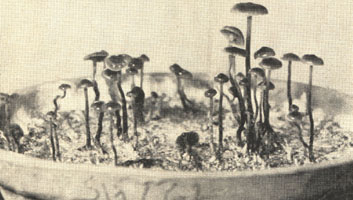
Growing in Paris, cultures brought back from Mexico by Heim produce mushrooms in his laboratory. These are Psilocybe mexicana Heim.
Little by little the properties of the mushrooms are beginning to emerge. The Indians who eat them do not become addicts: when the rainy season is over and the mushrooms disappear, there seems to be no physiological craving for them. Each kind has its own hallucinogenic strength, and if enough of one species be not available, the Indians will mix the species, making a quick calculation of the right dosage. The curandero usually takes a large dose and everyone else learns to know what his own dose should be. It seems that the dose does not increase with use. Some persons require more than others. An increase in the dose intensifies the experience but does not greatly prolong the effect. The mushrooms sharpen, if anything, the memory, while they utterly destroy the sense of time. On the night that we have described we lived through eons. When it seemed to us that a sequence of visions had lasted for years, our watches would tell us that only seconds had passed. The pupils of our eyes were dilated, the pulse ran slow. We think the mushrooms have no cumulative effect on the human organism. Eva Mendez has been taking them for 35 years, and when they are plentiful she takes them night after night.
The mushrooms present a chemical problem. What is the agent in them that releases the strange hallucinations? We are now reasonably sure that it differs from such familiar drugs. as opium, coca, mescaline, hashish, etc. But the chemist has a long road to go before he will isolate it, arrive at its molecular structure and synthesize it. The problem is of great interest in the realm of pure science. Will it also prove of help in coping with psychic disturbances?
My wife and I have traveled far and discovered much since that day 30 years ago in the Catskills when we first perceived the strangeness of wild mushrooms. But what we have already discovered only opens up new vistas for further study. Today we are about to embark on our fifth expedition to the Mexican Indian villages, again seeking to increase and refine our knowledge of the role played by mushrooms in the lives of these remote peoples. But Mexico is only the beginning. All the evidence relating to the primitive beginnings of our own European cultures must be reviewed to see whether the hallucinogenic mushroom played a part there, only to be overlooked by posterity.
Acknowledgements
For help in Middle America the author and Mrs. Wasson are indebted in Mexico chiefly to Robert J. Weitlaner; to Carmen Cook de Leonard and her husband, Donald Leonard; to Eunice V. Pike, Walter Miller, Searle Hoogshagan, and Bill Upson of the Summer Institute of Linguistics; also to Gordon Ekholm of the American Museum of Natural History, New York; and to Stephan F. de Borhegyi, director of the Stovall Museum of the University of Oklahoma. They are grateful for material aid granted to them by the American Philosophical Society and the Geschickter Fund for Medical Research, and also to the Banco Nacional de Mexico for lending them its private plane and the services of the excellent pilot, Captain Carlos Borja. For mycological guidance they are primarily indebted to Roger Heim, director of the Museum National d’Histoire Naturelle, Paris. For general advice they are most deeply indebted to Roman Jakobson of Harvard University, Robert Graves of Majorca, Adriaan J. Barnouw of New York, Georg Morgenstierne of the University of Oslo, L. L. Hammerich of the University of Copenhagen, Andre Martinet of the Sorbonne, and Rene Lafon of the Faculte des Lettres at Bordeaux. In the article the names of places and persons have been altered to preserve their privacy.
Via Psychedelic Library and Imaginaria. Thumbnail art on main page by Nicolas Rosenfeld.
Liked this post? Subscribe to my RSS feed to get much more!

